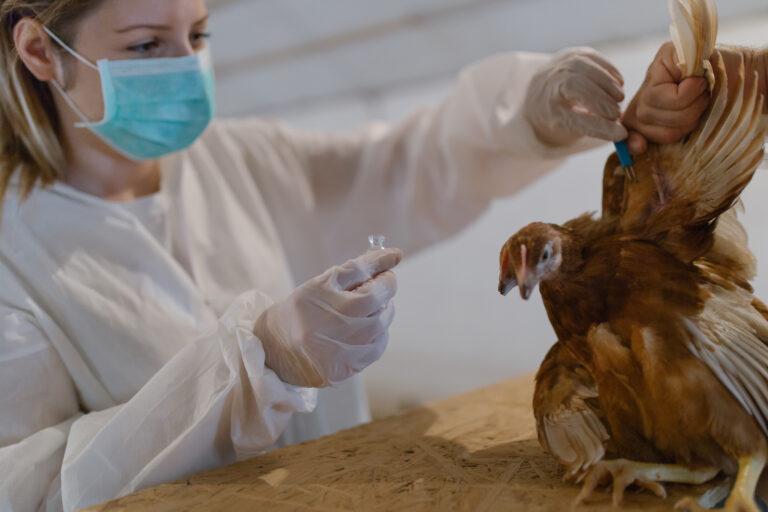Avian influenza (AI) is caused by type A influenza virus and is classified in numerous subtypes (H1-16 and N1-9). Most infections are subclinical in poultry, but some low pathogenicity (LP) AI strains can cause symptoms. High pathogenicity (HP) AI strains (H5 and H7 strains) produce severe systemic disease in gallinaceous poultry but variable disease and mortality in waterfowl. Aquatic birds are the natural hosts of Type A influenza viruses [2]. Host range of the virus and susceptibility have been heavily discussed [3].
Previously, outbreaks of HPAI in Europe were typically seasonal phenomenon caused by migratory waterfowl returning to overwintering locations in autumn, leading to transmission of the virus to poultry during the fall and winter, with limited circulation in the spring.
However, in 2021 instances of HPAI virus presence were identified in wild birds during the summer in breeding areas of northern Europe [4] and was followed by outbreaks in 2022 during the winter and spring among wild birds. This persisted through the summer, causing significant mortality in seabirds throughout Europe. Additionally, there was great global expansion of the virus in 2020 from west to east (Asia) [5] and the following years the virus spread to North and then South America [6].
Simultaneously, evolution and reassortment with local low pathogenic avian viruses happened and caused massive die-off events in Europe [7], in Chile and Peru in the wild bird population [8]. Moreover, numerous cases of transmission have been reported worldwide, involving both wild and captive mammal species [9].
Transmission to mammals have primarily been detected in individual animals, mostly wild carnivores that have either consumed infected or deceased wild birds or have come into contact with an environment heavily contaminated by the virus [1]. However, other than wild marine mammals and seabirds in the Americas [10–12] and farmed minks in Spain [13] and recently in Finland [14], pets (dogs and cats) got also infected with highly pathogenic avian influenza [15–17].
The primary mode of spread does not seem to be feline-to-feline (or canine-to-canine) transmission, rather exposure to infected wild birds or poultry. Feline-to (or canine-to)-human transmission has not been reported [18]. Although, it is recommended, in order to limit their exposure, to keep the dogs on lead while walking and cats and dogs preferably inside the house [19].
A few human infections were also reported with mild symptoms [20–22]. These cases were connected to either contact with infected birds or culling activities. Yet, cases of humans being infected with the influenza A (H5N1) virus only resulted in severe illness in individuals from Ecuador and Vietnam. Fatal cases were also documented in Chile and China after individuals were exposed to sick or dead backyard poultry or contaminated environments [23–25].
The most common early symptoms of bird flu infection in humans were also listed: diarrhoea, sickness, stomach and chest pain, bleeding from the nose and gums, and conjunctivitis [26]. As the infection progresses, additional symptoms (e.g., high fever, muscle pain, shortness of breath, cough, and persistent headaches) may arise. These symptoms could resemble those of other common infections like flu, making differentiation challenging.
However, the risk of infection with currently circulating avian H5 influenza viruses in Europe remains low for the general population, and low to moderate for occupationally or otherwise exposed people to infected birds or mammals [18]. Weekly reports of human infections and overviews of avian influenza can be found on the website of WHO and EFSA, respectively [27, 28].
Despite the significant events of wild bird deaths, outbreaks among poultry, and transmission to wild carnivore species, and humans exposed to the virus, only sporadic cases of human infections have been documented worldwide [1].
Progress in vaccination against avian influenza have been made in the last year, serious discussion about the administration and testing of potential candidates been carried out in Europe, in France, in the USA and in the Philippines [29–33]. However, vaccination is not a magic weapon or an instant solution, it should be used cautiously, wisely, and precisely with monitoring and surveillance programmes in place and with collaboration and communication between countries [34].
Vaccine should meet certain criteria, namely it should prevent infectious, clinical signs, death, and virus replication. Moreover, easy differentiation of vaccinated and infected birds should be made (DIVA principle). Vaccines should be used as a part of AI control program, mainly because they only provide subtype specific protection. Strict biosecurity practices and protocols must be established to prevent spreading of the virus. Proper surveillance must be in place in order to check effectiveness of the vaccines and to monitor field virus circulation [3].
To tackle avian influenza, it requires adopting a One Health strategy, involving swift sharing of outbreak information, sequence data and reference viruses, also strong cooperation among various sectors both at local and global levels. Communication can contribute by raising public awareness and acknowledging avian influenza viruses as hazards to both animal and human well-being. This approach aims to minimize the likelihood of interactions with potentially infected animals, thus mitigating the risks [1].
References
1. Adlhoch C, Baldinelli F (2023) Avian influenza, new aspects of an old threat. Euro Surveill 28:2300227. https://doi.org/10.2807/1560-7917.ES.2023.28.19.2300227/CITE/PLAINTEXT
2. Swayne DE, Boulianne M, Logue CM, McDougald LR, Nair V, Suarez DL, Wit S, Grimes T, Johnson D, Kromm M, Prajitno TY, Rubinoff I, Zavala G (2020) Diseases of Poultry. Wiley
3. David E. Swayne (2016) Animal Influenza, 2nd Edition, second edition. Wiley-Blackwell
4. Adlhoch C, Fusaro A, Gonzales JL, Kuiken T, Marangon S, Niqueux É, Staubach C, Terregino C, Aznar I, Muñoz Guajardo I, Baldinelli F (2022) Avian influenza overview May – September 2021. EFSA Journal 20:. https://doi.org/10.2903/j.efsa.2022.7122
5. Isoda N, Onuma M, Hiono T, Sobolev I, Lim H, Nabeshima K, Honjyo H, Yokoyama M, Shestopalov A, Sakoda Y (2022) Detection of New H5N1 High Pathogenicity Avian Influenza Viruses in Winter 2021–2022 in the Far East, Which Are Genetically Close to Those in Europe. Viruses 14:2168. https://doi.org/10.3390/v14102168
6. Mosaad Z, Elhusseiny MH, Zanaty A, Fathy MM, Hagag NM, Mady WH, Said D, Elsayed MM, Erfan AM, Rabie N, Samir A, Samy M, Arafa A-S, Selim A, Abdelhakim AM, Lindahl JF, Eid S, Lundkvist Å, Shahein MA, Naguib MM (2023) Emergence of Highly Pathogenic Avian Influenza A Virus (H5N1) of Clade 2.3.4.4b in Egypt, 2021–2022. Pathogens 12:90. https://doi.org/10.3390/pathogens12010090
7. Pohlmann A, Stejskal O, King J, Bouwhuis S, Packmor F, Ballstaedt E, Hälterlein B, Hennig V, Stacker L, Graaf A, Hennig C, Günther A, Liang Y, Hjulsager C, Beer M, Harder T (2023) Mass mortality among colony-breeding seabirds in the German Wadden Sea in 2022 due to distinct genotypes of HPAIV H5N1 clade 2.3.4.4b. Journal of General Virology 104:. https://doi.org/10.1099/jgv.0.001834
8. Gobierno del Perú (2022) Serfor pone a disposición Whatsapp exclusivo para atender casos de la influenza aviar en aves silvestres. https://www.gob.pe/institucion/serfor/noticias/680506-serfor-pone-a-disposicion-whatsapp-exclusivo-para-atender-casos-de-la-influenza-aviar-en-aves-silvestres
9. European Food Safety Authority, European Centre for Disease Prevention and Control, European Union Reference Laboratory for Avian Influenza, Adlhoch C, Fusaro A, Gonzales JL, Kuiken T, Marangon S, Mirinaviciute G, Niqueux É, Stahl K, Staubach C, Terregino C, Broglia A, Baldinelli F (2023) Avian influenza overview December 2022 – March 2023. EFSA J 21:e07917. https://doi.org/10.2903/j.efsa.2023.7917
10. Puryear W, Sawatzki K, Hill N, Foss A, Stone JJ, Doughty L, Walk D, Gilbert K, Murray M, Cox E, Patel P, Mertz Z, Ellis S, Taylor J, Fauquier D, Smith A, DiGiovanni RA, van de Guchte A, Gonzalez-Reiche AS, Khalil Z, van Bakel H, Torchetti MK, Lantz K, Lenoch JB, Runstadler J (2023) Highly Pathogenic Avian Influenza A(H5N1) Virus Outbreak in New England Seals, United States. Emerg Infect Dis 29:786–791. https://doi.org/10.3201/eid2904.221538
11. Leguia M, Garcia-Glaessner A, Muñoz-Saavedra B, Juarez D, Calvo-Mac C, Jara J, Silva W, Ploog K, Amaro, Lady, Colchao-Claux P, Uhart MM, Nelson MI, Lescano J (2023) Highly pathogenic avian influenza A (H5N1) in marine mammals and seabirds in Peru. biorxiv preprint. https://doi.org/10.1101/2023.03.03.531008
12. Gamarra-Toledo V, Plaza PI, Gutiérrez R, Inga-Diaz G, Saravia-Guevara P, Pereyra-Meza O, Coronado-Flores E, Quiroz-Jiménez G, Martinez P, Huamán- D, Nieto-Navarrete JC, Ventura S, Lambertucci SA (2023) Mass Mortality of Marine Mammals Associated to Highly Pathogenic Influenza Virus 1 (H5N1) in South America 2. biorxiv preprint. https://doi.org/10.1101/2023.02.08.527769
13. Agüero M, Monne I, Sánchez A, Zecchin B, Fusaro A, Ruano MJ, del Valle Arrojo M, Fernández-Antonio R, Souto AM, Tordable P, Cañás J, Bonfante F, Giussani E, Terregino C, Orejas JJ (2023) Highly pathogenic avian influenza A(H5N1) virus infection in farmed minks, Spain, October 2022. Eurosurveillance 28:. https://doi.org/10.2807/1560-7917.ES.2023.28.3.2300001
14. Louise Breusch Rasmussen, Alexandra Hudson (2023) Finland orders cull of 50,000 mink and foxes due to bird flu. Reuters. https://www.reuters.com/world/europe/finland-orders-cull-50000-mink-foxes-due-bird-flu-2023-08-01/
15. NEWS DESK (2023) Italy: 5 dogs, cat test positive for H5N1 avian influenza in Brescia, according to media report. Outbreak News Today. https://outbreaknewstoday.com/italy-5-dogs-cat-test-positive-for-h5n1-avian-influenza-in-brescia-according-to-media-report-63735/
16. Offlu, WOAH, FAO (2023) Infections with Avian Influenza A(H5N1) virus in cats in Poland. https://www.offlu.org/wp-content/uploads/2023/06/OFFLU-first-statement-Poland_28June.pdf?fbclid=IwAR3nmcdU4akYXdKO4NpJBe7Et0DRpdRgpxx0YhdgrQn4miWtcqHGYnHlsZk
17. Chief Veterinary Officer of Poland (2023) Communication of the III CVO on the disease of cats. https://www.wetgiw.gov.pl/main/komunikaty/Komunikat-III-GLW-w-sprawie-choroby-kotow/idn:2283
18. Adlhoch C, Fusaro A, Gonzales JL, Kuiken T, Melidou A, Mirinavičiūtė G, Niqueux É, Ståhl K, Staubach C, Terregino C, Baldinelli F, Broglia A, Kohnle L (2023) Avian influenza overview April – June 2023. EFSA Journal 21:. https://doi.org/10.2903/j.efsa.2023.8191
19. AFP (2023) EU urges keeping cats, dogs inside over bird flu. The News International. https://www.thenews.com.pk/print/1090340-eu-urges-keeping-cats-dogs-inside-over-bird-flu
20. Oliver I, Roberts J, Brown CS, Byrne AM, Mellon D, Hansen R DE, Banyard AC, James J, Donati M, Porter R, Ellis J, Cogdale J, Lackenby A, Chand M, Dabrera G, Brown IH, Zambon M (2022) A case of avian influenza A(H5N1) in England, January 2022. Eurosurveillance 27:. https://doi.org/10.2807/1560-7917.ES.2022.27.5.2200061
21. Aznar E, Casas I, González Praetorius A, Ruano Ramos MJ, Pozo F, Sierra Moros MJ, García Rivera MV, Sánchez Sánchez A, García Villacieros E, Saravia G, Iglesias-Caballero M, Román Marcos E, García San Miguel L (2023) Influenza A(H5N1) detection in two asymptomatic poultry farm workers in Spain, September to October 2022: suspected environmental contamination. Eurosurveillance 28:. https://doi.org/10.2807/1560-7917.ES.2023.28.8.2300107
22. Centers for Disease Control and Prevention (2022) U.S. Case of Human Avian Influenza A(H5) Virus Reported. https://www.cdc.gov/media/releases/2022/s0428-avian-flu.html
23. WHO (2023) Influenza at the human-animal interface Summary and risk assessment, from 27 January to 3 March 2023. https://cdn.who.int/media/docs/default-source/global-influenza-programme/influenza-at-the-human-animal-interface-summary-and-assessment–from-27-january-to-3-march-2023.pdf?sfvrsn=6065458a_1&download=true
24. WHO (2023) Human infection caused by avian influenza A(H5) – Ecuador. https://www.who.int/emergencies/disease-outbreak-news/item/2023-DON434
25. WHO (2023) Human Infection caused by Avian Influenza A (H5N1) – Chile. https://www.who.int/emergencies/disease-outbreak-news/item/2023-DON461
26. NHS (2022) Bird flu. https://www.nhs.uk/conditions/bird-flu/
27. WHO (2023) Avian Influenza Weekly Update 2023. https://apps.who.int/iris/handle/10665/365675
28. EFSA (2023) Avian influenza. https://www.efsa.europa.eu/en/topics/topic/avian-influenza
29. ANNA FELICIA BAJO (2023) PH making progress in procurement of avian influenza vaccines, says Marcos. GMA News. https://www.gmanetwork.com/news/topstories/nation/874855/ph-making-progress-in-procurement-of-avian-influenza-vaccines-says-marcos/story/
30. Jen Christensen (2023) US government is testing avian flu vaccines for birds, but ending the historic outbreak isn’t that simple. CNN. https://edition.cnn.com/2023/05/05/health/bird-flu-vaccine/index.html
31. Max Kozlov (2023) US will vaccinate birds against avian flu for first time — what researchers think. Nature News. https://www.nature.com/articles/d41586-023-01760-0
32. Jackie Linden (2023) France sets out plan for avian flu vaccination. WattPoultry. https://www.wattagnet.com/broilers-turkeys/diseases-health/article/15542868/france-sets-out-plan-for-avian-flu-vaccination
33. Natalie Kinsley (2023) France first in EU to order avian influenza vaccines. Poultry World. https://www.poultryworld.net/health-nutrition/health/france-first-in-eu-to-order-avian-influenza-vaccines/
34. WOAH (2023) World Assembly 90 th General Session World Organization for Animal Health. https://www.woah.org/app/uploads/2023/06/a-resos-2023-all.pdf

